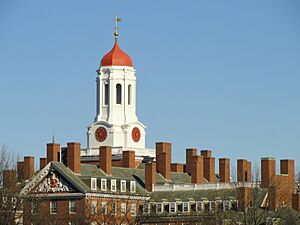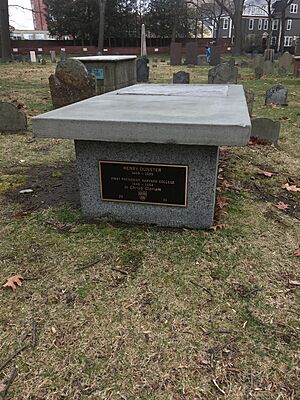Henry Dunster facts for kids
Quick facts for kids
Henry Dunster
|
|
|---|---|
| 1st President of Harvard College | |
| In office 1640–1654 |
|
| Preceded by | Nathaniel Eaton (as headmaster) |
| Succeeded by | Charles Chauncy |
| Personal details | |
| Born | November 1609 Bolholt, Bury, Lancashire |
| Died | February 27, 1659 (aged 49) Scituate, Massachusetts |
| Signature | |
Henry Dunster was a very important person in early American history. He was a religious leader and the very first president of Harvard College. Harvard is now a famous university, but back then it was just starting. Dunster helped shape Harvard and education in America. He is also known for having different religious beliefs than many people at the time.
Contents
Henry Dunster's Life
Early Life and Education
Henry Dunster was born in England, near a town called Bury. This was in November 1609. He went to Magdalene College, Cambridge, a famous university. There, he studied many languages, including ancient ones. He became known as a smart scholar, especially in Hebrew. He earned his first degree in 1630 and a master's degree in 1634.
After college, Dunster worked as a headmaster at Bury Grammar School. He also served as a religious assistant at a church in Bury.
Leading Harvard College

In 1640, Henry Dunster moved to America, to a place called Boston, Massachusetts. He was asked to lead a new school called Harvard College in Cambridge, Massachusetts. The person in charge before him had been dismissed. So, on August 27, 1640, Dunster became Harvard's first president.
He based Harvard's teaching style on famous schools in England, like Eton College and the University of Cambridge. For many years, he taught the entire school curriculum by himself! The first group of students graduated from Harvard in 1642.
Dunster was very good at managing Harvard's money. This was important because the area was going through a tough economic time. He even acted as the school's treasurer for almost ten years. He also helped create Harvard's first official rulebook, called the Charter of 1650. This charter still guides Harvard University today, showing how strong his leadership was.
A Different Belief
In 1653, Dunster had a different idea about a religious practice called infant baptism. Many people in the Massachusetts Bay Colony believed babies should be baptized. But Dunster believed that only adults should be baptized. This was a big difference from the main religious views of the colony's leaders.
The leaders tried to convince Dunster to change his mind. However, he stuck to his beliefs. Because he was the president of Harvard, a school meant to support the colony's religious mission, his different view caused problems. The leaders felt he was a threat to their society's stability.
So, in 1654, Dunster left Harvard. He moved to a nearby area called Plymouth Colony. There, he became a minister in a town called Scituate, Massachusetts. Henry Dunster passed away there on February 27, 1659.
His Family and Lasting Impact
Henry Dunster was married two times, and both of his wives were named Elizabeth. His first wife was Elizabeth Glover. They married in 1641, but she passed away in 1643. She left him with some land and the colony's first printing press.
In 1644, Dunster married Elizabeth Atkinson. They had five children together.
Today, one of the twelve student dorms at Harvard University is named Dunster House. It is named after Henry Dunster to remember his important role as Harvard's first president.


